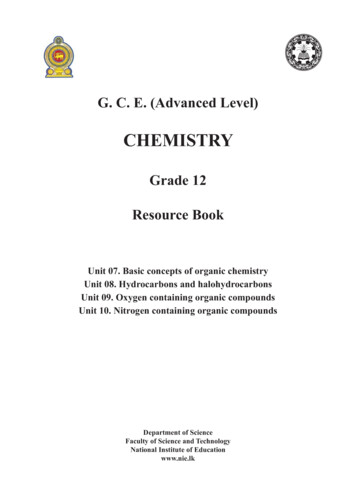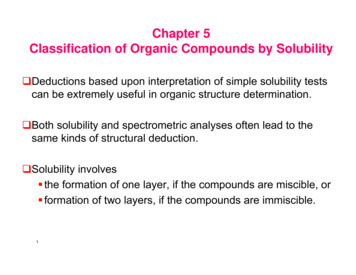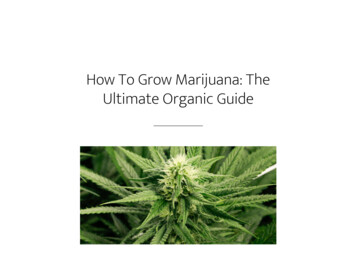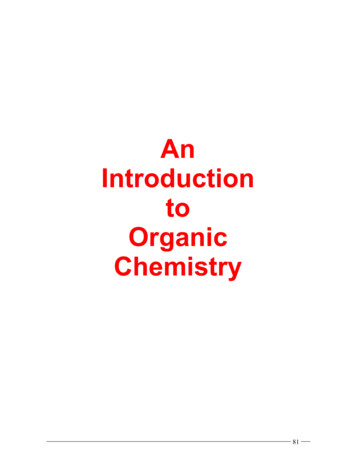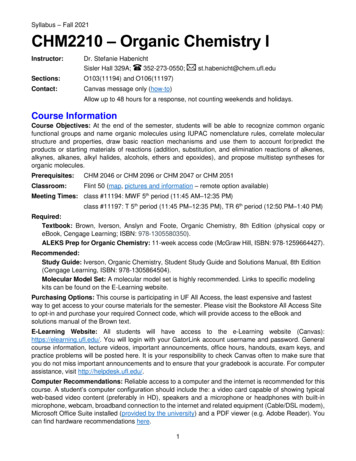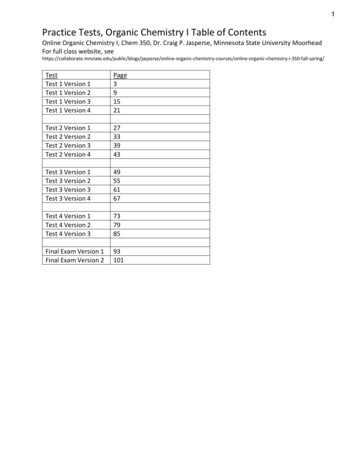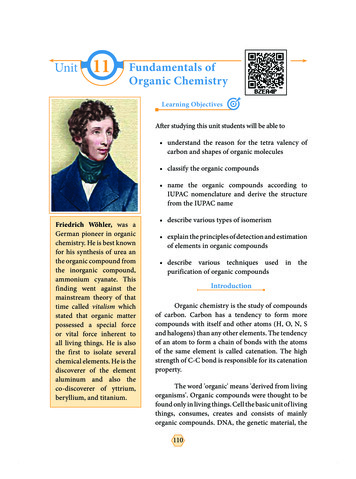
Transcription
Unit11Fundamentals ofOrganic ChemistryLearning ObjectivesAfter studying this unit students will be able to understand the reason for the tetra valency ofcarbon and shapes of organic molecules classify the organic compounds name the organic compounds according toIUPAC nomenclature and derive the structurefrom the IUPAC nameFriedrich Wöhler, was aGerman pioneer in organicchemistry. He is best knownfor his synthesis of urea anthe organic compound fromthe inorganic compound,ammonium cyanate. Thisfinding went against themainstream theory of thattime called vitalism whichstated that organic matterpossessed a special forceor vital force inherent toall living things. He is alsothe first to isolate severalchemical elements. He is thediscoverer of the elementaluminum and also theco-discoverer of yttrium,beryllium, and titanium. describe various types of isomerism explain the principles of detection and estimationof elements in organic compounds describe various techniques used in thepurification of organic compoundsIntroductionOrganic chemistry is the study of compoundsof carbon. Carbon has a tendency to form morecompounds with itself and other atoms (H, O, N, Sand halogens) than any other elements. The tendencyof an atom to form a chain of bonds with the atomsof the same element is called catenation. The highstrength of C-C bond is responsible for its catenationproperty.The word 'organic' means 'derived from livingorganisms'. Organic compounds were thought to befound only in living things. Cell the basic unit of livingthings, consumes, creates and consists of mainlyorganic compounds. DNA, the genetic material, the110Unit 11 revised.indd 11027-08-2018 17:53:46
The formation of four covalentbonds can be explained as below. Duringbond formation, one of the electronsfrom 2s orbital is promoted to 2pz orbital.The formation of four sigma bonds bycarbon can be explained on the basisof sp3 hybridisation of carbon. Carbonforms multiple (double and triple) bondsin certain compounds. These can beexplained by sp2 and sp hybridisation ofcarbon. The carbon forms relatively shortbonds which enable the lateral overlapof unhybridised 2p orbitals of sp2 and sphybridised carbon to form one and two pibonds respectively.lipids, that forms our cell membrane andthe glycogen the energy reserve storedin our liver are all organic compounds.Except few inorganic compounds likesalt, water etc. all others such as food,medicine, clothing, cosmetics, fuel etc.are compounds of carbon. All the essentialbiochemical reactions are also organic innature leading to the fomation variousessential bioorganic molecules such aslipoproteins, phospolipids, glycolipidsetc.Synthesis of acetic acid by kolbeand methane by Berthlot, confirmed thatorganic compounds can be synthesizedin laboratory. Since then, millions oforganic compounds were synthesisedand characterised. The field of organicchemistry is very vast and its principlesfind applications in many industriesincluding food, textile, pertrochemical,pharmaceutical, dye, polymers, fetiliser,cosmetics etc. Discussing the importanceof organic chemistry is just like describinga drop of water in a mighty ocean.Molecular stucture can be derivedfrom the type of hybridisation. An sp3hybridised carbon will have a tetrahedralgeometry, a sp2 hybridised carbon willhave trigonal planar geometry. and sphybridised carbon will have a lineargeometry.Characteristics of organic compounds:All organic compounds have the followingcharacteristic properties.The knowledge of chemicalbonding and molecular structure will helpin understanding the properties of organiccompounds. We know that, the carbon hasfour valance electrons and its ground stateelectronic configuration is 1s2 2s2 2p2.An atom can attain noble gas electronicconfiguration either by transferring orsharing of electrons. It is not possible forthe carbon to form either C4 or C4- ions toattain the nearest noble gas configuration,as it requires large amount of energy. Thisimplies that carbon cannot form ionicbond. Almost in all compounds of carbon,it forms four covalent bonds.1.They are covalent compounds ofcarbon and generally insoluble inwater and readily soluble in organicsolvent such as benzene, toluene,ether, chloroform etc.2.Many of the organic compounds areinflammable (except CCl4).Theypossess low boiling and meltingpoints due to their covalent nature3.Organic compounds are characterisedby functional groups. A functionalgroup is an atom or a specificcombination of bonded atoms that111Unit 11 revised.indd 11127-08-2018 17:53:46
react in a characteristic way, irrespective of the organic molecule in which it ispresent. In almost all the cases, the reaction of an organic compound takes place atthe functional group. They exhibit isomerism which is a unique phenomenon.4.Homologous series: A series of organic compounds each containing a charactericfunctional group and the successive members differ from each other in molecularformula by a CH2 group is called homologous series. Eg.Alkanes: Methane (CH4), Ethane (C2H6), Propane (C3H8) etc.Alcohols: Methanol (CH3OH), Ethanol (C2H5OH) Propanol (C3H7OH) etc.)Compounds of the homologous series are represented by a general formula AlkanesCnH2n 2, Alkenes CnH2n, Alkynes CnH2n-2 and can be prepared by general methods. Theyshow regular gradation in physical properties but have almost similar chemical property.11.2 Classification of organic compoundsThe existing large number of organic compounds and ever-increasing number havemade it necessary to classify them. They may be classified based on their structure or thefunctional group.11.2.1 Classification based on the structure:Organic CompundsAcyclic or open chain or aliphaticcompoundsExample : CH3–CH2–CH3 (propane)Cyclic compoundsHeterocyclic compoundsHomocyclic compoundsAlicyclic Compounds orcarbocyclicCH2Alicyclic compoundsAromaticcompoundsAromatic compoundsNTHFCH2H2CCyclopropaneBenzenoid compounds or aromatichomocyclicOHPyridineONon-Benzenoid compounds alsoaromatic homocyclicPhenolazulene112Unit 11 revised.indd 11227-08-2018 17:53:46
Based on the above classification let usclassify the following compounds.11.2.2 Classification based on functionalgroups:1.Table 11.1 Class of compounds and theirfunctional groupClassify the following compoundsbased on the structureGeneral formula(R - Alkyl group)1Alkene–CnH2n2Alkyne–CnH2n-23Alkyl idCS. No.Class ofcompoundsFunctional groupi) CH C– CH2–C CHii) CH3 – CH2 – CH2 - CH2– saturated open chain compound(ii)saturated open chain compound(iii)aromatic benzenoid compound(iv)8alicyclic compoundEvaluate Yourself9?101) Give two examples for eachof the following type of rideCOROOR-OHR-O-R'OCR- XCOR-CHOR-CO-R'R-COOHRCOOR'R-CO-O-CO-R'R-COX11Acyl chloride(i) non-benzonoid aromatic,12Sulphonic acidSO3HR-SO3H(ii) aromatic heterocyclic,13Nitro alkaneNO2R-NO2(iii) alicyclic and14AmineNH2R-NH215Amide(iv) aliphatic open chain.CXOCN H2R-CO-NH2113Unit 11 revised.indd 11327-08-2018 17:53:47
SHR-SH23Thioalcoholsor thiols24Thioethers25Imines2627282930SRR-CH henolsImideNH2OHRoot word denotes the number of carbonatoms in the longest continiuous chainin molecules. Prefix denotes the group(s)attached to the main chain which isplaced before the root. Suffix denotes thefuntional group and is paced after the rootword.R-S-R'NHNitrosoprefix root word suffixTable 11.2 Number of carbons inparent chain and the correspondingroot 3 Nomenclature of organiccompounds:The International Union of Pure andApplied Chemistry (IUPAC) is the worldauthority on chemical nomenclature andterminology, naming of new elements inthe periodic table standardized methodsRoot wordR-CNChain length(or)no. of carbon atomNRoot wordC(Nitrile)Chain length(or)no. of carbon atomsCyanideGeneral formula(R - Alkyl group)Functional groupClass ofcompoundsS. No.16for measurement; atomic weights, andmany other critically-evaluated data.According to IUPAC recommendationsto name any organic compound, it isconsidered as a derivative of its parentsaturated hydrocarbon. The IUPAC nameof an organic compound consists of 0Pentacont-114Unit 11 revised.indd 11427-08-2018 17:53:49
C13Tridec C90Nonacont-C16Hexadec-C100Hect-Table 11.4 Secondary sufix andprefixes for some functional groups:Suffix: There are two types of suffix. Theyare primary suffix and secondary suffixPrimary suffix: It denotes the saturation/unsaturation of organic compounds. It isadded immediately after the root word.Primary suffix for various saturated andunsaturated carbon chains are as follows:PrimarysuffixSaturated, C-CaneCTwo CThree Chydroxy--olThioalco-SHmercapto-thiolCKetoneseneC bondsdieneCOacidCEstersOOne CC bondyneTwo CC ecarboxy--oic acidAlkoxy–-oateOHAcid chlo-Nitriles-alHOCarboxylicAminestrieneformyl-OCC bondC bondsOHAldehydesUnsaturated carbon chainoneAlcoholsholsTable 11.3 Primary suffix for varioussaturated and unsaturated carbonchainsName & type of carbonchainSecondary suffixRoot wordHexacont-PrefixChain length(or)no. of carbon atomC60Functional groupRoot wordDodec-Class of organiccompoundsChain length(or)no. of carbon atomsC12Secondary suffix: It is used to denotethe nature of functional group present inthe organic compound. It is added to theprimary suffix by removig its terminal ‘e’.Secondary suffix names for some functionalgroups is listed below in table 11.4XN onicacid115Unit 11 revised.indd 11527-08-2018 17:53:50
Prefix: Substituents that are attached to theparent carbon chain are denoted by addingprefix names before the root word. The prefixnames for some common substituents arelisted below. If the functional groups are notpart of the parent chain, they are consideredas substituents. In such cases its prefix nameis added before the root word. Prefix namesfor some functional groups mentionedalong with their secondary prefix are listedin table 11.4Substituent group-CH2-CH Nitro-NONitrosoN-OR1,1-dimethy lethyl(tert-butyl)-CH2-CH (CH3)-CH2-CH3 2-methyl butylCH2-CH (CH3)32,2-dimethyl propyl(neopentyl)Prefix-F N2-methyl propyl(iso propyl)-CH2-CH2-CH2-CH2-CH3 1-pentyl (n-pentyl)Table 11.5 List of substitutents andtheir Prefix namesSubstituent groupPrefix11.3.1 IUPAC rules for nomenclatureof organic compoundsThe following steps should befollowed for naming an organic compoundas per IUPAC nomenclature.1. Choose the longest carbon chain. (Rootword). Consider all the other groupsattached to this chain as substitutents.DiazoAlkoxy-OCH3 (or) -OMeMethoxy2. Numbering of the longest carbon chain-OC2H5 (or) -OEtEthoxy-CH3 (or) –MeMethyl3. Naming of the substituents (prefixes orsuffixes)-C2H5 (or) -EtEthyl-CH2-CH2-CH31- propyl (n propyl)4. Arrange the substitutentsalphabetical order-CH(CH3)22-propyl (iso-propyl)5. Write the name of the compound as below-CH2-CH2-CH2-CH3inthe"prefix root word primary suffix secondary suffix"1-butyl (n-butyl)116Unit 11 revised.indd 11627-08-2018 17:53:50
117Unit 11 revised.indd 11727-08-2018 17:53:50Choose thelongest carbonchain (parentchain)Step No.ii) If more than one functional1CHO 7C chain CHO Wronggroup is present, the one with5highest precedence should be HOOC1 2C 3CH 4CH CH222part of the parent chain. Order7C chainof precedence of functionalCH3 with COOH 6 CH2Correctgroup is -COOH -SO3H 7 CH3-COOR, -COX CONH2 -CN -CHO -CO- -OH -SH -NH2 -C C- -C C- C-C -O- -X -NO2Two SubtituentCorrect57C-Chain6CH26C-ChainCH 2 CH 3CH CH 2 CH 31HOOC7C chainwithCOOHGroupCorrect7CH36CH27C chain without COOH group5342C CH2 CH2 CH OHCH3CH314C Chain with COOH - WrongOne SubtituentCH 3CH 3 CH5C Chain Wrong7CH3longest chain of 7 C atomCH 3i) If any of the fucntional groupsCorrect(-OH, -CHO, -COOH, -CN,Correct4C Chain with COOH-COOR, CONH2, -NH2, COR,4C Chain with CHOand double bond,COX, -SO3H, -SH, -SR) are423432CH3 CH2 CH CH CH 2present, choose the longest CH3 CH CH2 CH3without CHO Wrong5C Chain without COOH Wrongcarbon chain in such a way that 4C Chain11CHOCOOHit contains functional groups.46C-Chain53412CH 3 C CH 2 CH 2 CH CH 3CH 3Compoundcontainsfunctional groupor multiple bondor both3CH 3 CH 2 CH 35C Chain2longest chain of 5 C atomCH 3 CH CH CH 2 CH 31CH 343512CH 3 CH 2 CH CH 2 CH 34C-ChainIllustrationsChoose the chain with maximumnumber of substituentsRuleTwo chains ofequal lengths.Conditions
118Unit 11 revised.indd 11827-08-2018 17:53:51ConditionsPresence ofsubstituents(All otheratoms or groupsattached to theparent chain areconsidered assubstitutents)More numberof substitutents/functional grouppresentStep No.Numbering theparent chainfrom one endto anothersubstitutentsIllustrations65CH3431234CH3 CH2 CH CH23 2 Æ correct45 6 Æ wrong CH2 CH CH CH3CH2CN2 3421 Æ correct 1wrongCO NH 21iii) If the same functional group15C chain with 25is present more than once,COOHCOOH COOH groupas part of the Chain (Correct)choose the very longest carbon432HCCHCHCHCHCHCH2 CH33222chain in such a way that it8C Chain Two - COOH group as substituent - Wrongcontains maximum number ofthat functional groupNumbering should be done in4211 234566 53CH 3 CH2 CH2 CH CH2 CH3CH3 CH2 CH2 CH CH2 CH3such a way that it gives the lowestpossible number to the carbonCH3CH3atom carrying the substituentNumbering should start fromCorrectWrongterminal functional groups such as-CHO, -COOH, -COOR, -CONH2,-CN etc. (if present)123456 Æ wrongNumbering should be done in such 1234 Æ wrongCHCHCHCHCH CH 2CHCHCHCH3222323a way that the sum of the number2234 Æ correct34 Æ correctwhich indicates the position ofCOOHCHO11the subtituents/functional group(Locant) gives the lowest numberRule
119Unit 11 revised.indd 11927-08-2018 17:53:51Two substituentsare present onidentical positionwith respect to theparent chain end.Order of precedence of functionalgroup isWhen more thanone functionalgroup havesame locant thefollowing order ofpriority should befollowed.Assign the lowest numberaccording to the alphabeticalorder of the name of thesubstituent.-COOH -SO3H -COOR, -COX CONH2 -CN -CHO -CO- -OH -SH -NH2 -C C- -C C C-C -O- -X -NO2 .RuleConditions6CH3C2H 5CH3Incorrect numberingOH32654CH3 CH CH2 CH CHCH3 CH2 CH CH2 CH CH2 CH3123 4567 IncorrectEthylMethylOH group C C Correct1CH3OH3452CH CH 2 CH CHIllustrations1CH3765 4321 CorrectNaming the substituents / functional group / side chain using the prefixes / suffixes given in table 11.3 primary suffix for various saturated andunsaturated carbon chains, Table 11.4 Secondary suffix and prefixes for some functional groups and table 11.5 prefix name for some substituents.4. Arrange the Two or more These substituent prefixed withCH3CH3 C2H5substitutents in substituents are their position number are arranged 1the alphabetical present on the in alphabetical order (irrespective CH3 CH CH CH2 CH2 CH3CH3 CH2 C CH CH2 CH34234 36521orderparent chain,of the position number) before rootC2H 5CH2 CH2 CH3word (The prefixes di-, tri-, etc. are6753-Ethyl-2-methyl3,4Diethyl-4-methylnot taken into consideration forgrouping alphabetically)Step No.
The following are guide lines for writing IUPAC of the organic compound.1.The IUPAC names are always written as single word, with notable exception of organicsalts, acids and acid derivatives.2.Commas are used between two adjacent number or letter symbols, and hypens areused to separate numbers and letter symbol in names Eg: 2,2-Dimethyl-3-hexeneN,N-Dimethyl methanamide3.Structural prefix such as, meso-, cis-, trans-, are italicised and joined to the name by ahypen. These prefixes are omitted in alphabetising compound names or in capitalisingnames at the beginning of a sentence.Eg:trans-2-Butene4.Structural prefixes such as di, tri, tetra are treated as a part of the basic name andtherefore are neither italicised nor separated by a hypen. These prefixes are not takeninto account in alphabetising compound names eg: 4- Ethyl -2,2-dimethyl hexane.5To name alicyclic compounds , the additional rules should be followed as illustratedin the table 11.xTable 11.6 Rules for naming of alicyclic compounds:RuleIn the naming of such compounds a prefixcyclo is added to the word cyclooctaneC2H5OHCH3If only one substituent is present on the ring,then it is not required to give its positionethylcyclobutaneCH3CH323If two or more substituents are present on thering, the numbering of ring is done according tolowest set of locant rule. Alicyclic compoundsalso follow the numbering rules of thylcyclohex-1-ene120Unit 11 revised.indd 12027-08-2018 17:53:51
RuleIllustrationCH3CH3CHCH3CH3CH1234CH3 CH CH2 CH31234CH3 CH CH2 CH3412-Propylcyclobutane(derivative of cycloalkane)C4 3123-Chlorocyclobut(Double bond get p3-Chlorocyclobut-1substituent-Cl f(Double bondget prenumbering)substituent-Cl fornumbering)If the ring contains lesser number of carbon2-Cyclopropylbutane2-Propylcyclobutaneatoms than that of alkyl group attached to it,(derivative of cycloalkane) (derivative of alkane)the compound is named as derivative of ative of cycloalkane) (derivative of alkane)and the ring is considered as a substituentCH3CH 3Clgroup to the alkane,otherwiseit 1is named23as4CHCHCHCHCH323derivative of cycloalkane4 313223-Chlorocyclobut-1-ene(Double bond get prefernce oversubstituent-Cl fornumbering)2-Cyclopropylbutane(derivative of alkane)OCH33CH CHO2 1If the side chain contains a multiple bond ora functional group, then the alicyclic ring istreated as the substituent irrespective of thesize of the ringCH3 CH2 2-one32 1CH3 CH ut-2-en-1-yl)-propanalCH321CH2 CH CH2243CH2 CH CH 4-(cyclopent-3-en-1-yl)-3-methylbutanoic acidNO2231342CH CH1COOH53-(3-nitrocyclopentyl) - prop-2-enoicacid121Unit 11 revised.indd 121CO15CH3234If both ring as well as the side chain containthe functional group, then parent hydrocarbonis decided on the basis of principal groupwhich is further based on preferential order offunctional groups42If the alicyclic ring contains a multiple bondand the side chain contains a functional group32the1the compound is named as derivativeCHof3 CH CHOside chain and the ring is treated as substituent1327-08-2018 17:53:52
RuleIllustrationOHOH1If both alicyclic ring and the side chain containsame functional group, the parent hydrocarbonis selected on the basis of number of carbonatoms in the ring and side chain265CH2 CH CH3123342-(2-hydroxypropyl)cyclohexan-1-olIf more than one alicyclic rings are attached tothe single chain of carbon atoms, the compoundis named as a derivative of alkane and alicyclicrings are treated as substituent irrespective ofthe number of atom in the ring or chain21CH2 - CH21-(cyclobutyl)- 2- (cyclopropyl) - ethaneIf the alicyclic ring is directly attached to thebenzene ring the compound is named as aderivative of benzenecyclopentylbenzeneCOOH4If the alicyclic ring has a functional groupalong with some substituent on the ring, thenthe appropriate prefixes and suffixes are usedto represent such groups, COOHand numbering isdone in such a way that the functional groupis not counted for word root rather appropriatesuffixes are used to represent such groupscyclohexanecarboxylic acid12 CONH232-carbamoylcyclobutane-1-carbCOOH412 CONH232-carbamoylcyclobutane-1-carboxylic acidcyclohexanecarboxylic acidEvaluate YourselfCOOH?2) Write structural formula for the following compounds(i) Cyclohexa-1, 4-diene (ii) Ethynyl cyclohexaneNOMENCLATURE OF AROMATIC COMPOUNDS:An aromatic compound consists of two parts nucleus and side chain(A)Nucleus: The benzene ring present in aromatic compound is called nucleus. It isrepresented as follows122Unit 11 revised.indd 12227-08-2018 17:53:52
If more than one hydrogen atom ofbenzene ring is replaced by some other atomor group, then their position is mentionedby Arabic numerals 1,2,3 . In case ofdisubstitution, respective position of twogroups can also be mentioned as follows.HorororCHCHCCCHCHH(B)Side chain: Alkyl or any otherortho - adjacent; represented as - ometa - alternate; represented as - mPara - opposite; represented as - paliphatic group attached to the benzenenucleus by replacing one or more hydrogenatom is called the side chainRAromatic compounds are basically oftwo types:Alkyl group (side chain)1. Nuclearsubstitutedaromaticcompounds: These are the compoundsin which the functional group is directlyattached to the benzene ring. They arenamed as derivatives of benzene.nucleusIf one hydrogen atom, (or) two hydrogenatoms or three hydrogen atoms are replacedin the benzene ring by some other groups,they are termed as mono substituted, disubstituted or tri substituted thyl benzene 1,2-dimethyl benzene(o-xylene)(toluene)CH3CH3ClClCH 31,3-dimethyl benzene(m-xylene)Cl,,Clmonosubstituted disubstitutedtrisubstitutedClCH31,4-dimethyl imethyl benzene(mesitylene)34(1, 2)(1, 3)(ortho-adjacent represented as o- (meta alternate) represented as mq (60 )q (120 )CH31,2,3-trimethyl benzeneCH3Xorthoorthometa(1, 4)(para opposite) represented as pq (180 )metaX substituentCH3paraCH31,3,4-trimethyl benzene123Unit 11 revised.indd 12327-08-2018 17:53:52
NuclearsubstituaedaramaticHalogen derivatives compounds.ClClchlorobenzeneAryl groupsCH2Cloror orobenzeneHCCH3or ene2. Side chain substituted aromaticcompounds: These are the compoundsin which the functional group is presentin the side chain of the benzene ring.These are named as phenyl derivatives ofthe corresponding aliphatic compounds.orC6H5phenyl (chloromethane)(benzyl chloride)Co-tolyl or 2-tolylbenzoCH3CH3Side chain substitutedm-tolyl or 3-tolylCHCl 2CH2 H4p-tolyl or 4-tolyl o/m/p tolylSelection of parent hydrocarbonout of side chain and benzene ringis based on (more or less) somerule as for the alicyclic compounds.CCl 3phenyltrichloromethane(benzotrichloride)Evaluate Yourself?3) Write structural formula for the following compounds(i) m - dinitrobenzene (ii) p-dichloro benzene (iii)1, 3, 5- Trimethyl benzene124Unit 11 revised.indd 12427-08-2018 17:53:53
Table 11.3.1. 2Compound Structure and IUPAC NamePrefix withposition pentane–2,2,5- hylbutaneal2-ethylbuteneoic acid2-formyl-2-methylheptaneoic acid5-hydroxy-2,2dimethylheptaneoic acid2-ethyl4-propylpentaneoic acidCH3CH3 CH2 CH CH2 CH3123453-methylpentaneCH 3CH 31CCH 2 CH 2 CH CH 3234CH 356 CH 27 CH 32,2,5-trimethylheptane12345CH 3 CH CH CH2 CH 3CH3 CH 2 CH33-ethyl-2-methylpentane234CH 3 CH CH 2 CH 31CHO2-methylbutanal234CH 3 CH 2 CH CH CH 21COOH2-ethylbut-3-enoic acidCHO1 2345HOOCC CH2 CH2 CH2PrimaryFunctionalgroup6 CH2CH37 CH32-formyl-2-methylheptanoic acid1HOOCCH 32345C CH 2 CH 2 CH OH6 CH 2CH 37 CH 35-hydroxy-2,2-dimethylheptanoic acid15COOHCOOH243H3C CH2 CH CH2 CHCH2CH2CH32-ethyl-4-propylpentanedioic acid125Unit 11 revised.indd 12527-08-2018 17:53:53
Compound Structure and IUPAC NamePrefix withposition hexane–2-Methylbutaneal2-ethylbut3- eneoic acid4-methylhexenenitrile2-methylbut3 - eneamidehex4 - ene2- ol3-ethyl5- yl4-methylheptane–2,4-dimethylpent2 - ene–CH 3 CH 2 CH 2 CH CH 2 CH 3654321CH 33-methylhexane234CH 3 CH CH 2 CH 31CHO2-methylbutanal234CH3 CH2 CH CH CH21COOH2-ethylbut-3-enoic acid65432CH3 CH2 CH CH21CH2CNCH34-methylhexanenitrileCH2 CH CH CH34321 CONH 22-methylbut-3-enamideOHCH 3 CH CH 2 CH123CH4CH 356hex-4-en-2-olCH3C2H 5CH3 CH2 CH CH2 CH CH2 CH376543213-ethyl-5-methylheptaneCH 312CH 3 CH3CH456CH 2 CH 2 CH 3C2H 53-ethyl-2-methylhexaneCH 3 C2H5CH 3 CH 2 C4CH3CH 2 CH 321CH 2 CH 2 CH 35673,4-diethyl-4-methylheptaneCH 3CH 31CCH 3CH CH CH 323452,4-dimethylpent-2-ene126Unit 11 revised.indd 12627-08-2018 17:53:54
Compound Structure and IUPAC Name76543CH 3 CH CH CH2CPrefix withposition hept1, 3, 5 - triene––pent1- methylpropane1-olpropaneoic entane3 - one1CH CH 2CH 33-methylhepta-1,3,5-trieneCH3 CH2 CH2CCH543211-pentyne (or) pent -1- yne1 CH 32H3CCOH3 CH 32-methyl propan-2-olH 3CCHCH 245CH 2321CH 2OHCH 34-methylpentan -1- olCH33H3C1CCH 2OH2CH32,2-dimethyl propan -1- olOCH3 CH 2 C OH32512314propanoic acid32CH 2 CH 2 CH CH 21CHOCH 343-methyl-5-(1,3-dimethylcyclobutyl)pentanal321CH CHOCH 32-cyclopentylpropanal3CH 321CH CHO124312-(cyclobut-2-enyl)propanal2CH 3 CH 2345C CH 2 CH3Opentan-3-one127Unit 11 revised.indd 12727-08-2018 17:53:55
Compound Structure and IUPAC Name543CH 3 3- ene2-one–pent1- yne3- one3-phenylprop2- eneoic exa1CH CCH 3Prefix withposition numberCH 3O4-methylpent-3-en-2-one5432CH 3 CH 2 C1C CHOpent-1-yne-3-oneCHCH32COOH13phenyl prop -2-enoicacidCH 3 CH2 CH 2 NH CH3321N-methylpropan-1-amine1CH 3CH 3 CH3NHCH 32N-methylpropan-2-amineCH 3321CH 3 CH 2 CH 2 NCH 3N,N-dimethylpropan-1-amineCH 3321CH 3 CH 2 CH 2 NCH 2 CH ethylbenzenamineCH2OH6543CH2CH3 CH2 CH CH21CH2 COOHOHaneoic acid4-hydroxy-3-(2-hydroxyethyl)hexanoic acid128Unit 11 revised.indd 12827-08-2018 17:53:56
11.2 Structural representation oforganic compoundstriple bond (1σ bond, 2π bond). Lone pairof electrons on heteroatoms may or maynot be shown. This represents the completestructural formula.Molecular formula of a compoundis the simplest, least informativerepresentation, showing the ratio ofatoms present. The structure of an organiccompound can be represented using anyone of the below mentioned methods.This structural formula can befurther abbreviated by omitting some or allof the dashes representing covalent bondsand by indicating the number of identicalgroups attached to an atom by a subscript.The resulting expression of the compound iscalled a condensed structural formula.1. Lewis structure or dot structure,2. Dash structure or line bond structure,3. Condensed structureFor further simplification, organicchemists use another way of representingthe structures in which only lines are used.In this type of representation of organiccompounds, carbon and hydrogen atomsare not shown and the lines representingcarbon-carbon bonds are shown in a zigzagfashion. The only atoms specifically writtenare oxygen, chlorine, nitrogen etc. Theserepresentations can be easily understood bythe following illustration.4. Bond line structureWe know how to draw the Lewisstructure for a molecule. The line bondstructure is obtained by representing thetwo electron covalent bond by a dash orline (-) in a Lewis structure. A single lineor dash represents single σ covalent bond,double line represents double bond (1σbond, 1π bond) and a triple line dieneC4H6HComplete structuralformula (dash �CH2–OHCCCCH2 CH–CH CH2HH H Ht-butyl chlorideC4H9ClHHHCH3CCCOHOHH H HH H H HCBond lineStructureCH3ClCClClCH3CH H H129Unit 11 revised.indd 12927-08-2018 17:53:56
MolecularforumulaComplete structuralformula (dash CCCCCondensedStructureCHCHCH2Bond lineStructureCH3HHCH2CH2CHHCH3HCH H HMolecular modelsFrame work ModelFrame work ModelBall and Stick ModelSpace filling modelFig 11.3 Methane - Molecular ModelsMolecular models are physical devices that are used for a better visualisation andperception of three dimensional shapes of organic molecules. These are made of wood,plastic or metal and are commercially available. (i) Frame work model (ii) Ball and stickmodel & (iii) space filling model. In the frame work model only the bonds connecting theatoms themselves are shown. This model emphasizes the pattern of bonds of a moleculewhile ignoring the size of the atom. In the ball and stick model, both the atoms and thebonds are shown. Ball represent atoms and the stick a bond. Compounds containing C Ccan be best represented by using springs in place of sticks and this model is termed as balland spring model. The space filling model emphasizes the relative size of each atom basedon its vander-waals radius.Three dimensional representation of organic molecules:The simplest convention is solid and dashed wedge formula in which 3-D image of amolecule can be perceived from two dimensional picture. In this representation a tetrahedralmolecule with four atoms or group a,b,c and d bonded to it can be represented by a wedge) (or a heavy line) is used to indic
Organic Chemistry. 11. Friedrich Wöhler, was a German pioneer in organic chemistry. He is best known for his synthesis of urea an the organic compound from the inorganic compound, ammonium cyanate. This finding went against the mainstream theory of that time called . vitalism. which stated that




